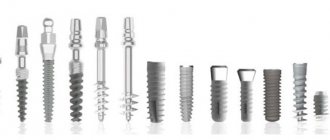The inlay is a one-piece structure, the lower part of which is similar to a stump (therefore a stump). It takes into account the characteristics of the destroyed tooth, so it can be single, double or triple. In complex cases, it may consist of individual elements. The upper part is made of any shape, in accordance with the impression taken. The inlay can be installed without a crown, completely repeating the shape of the tooth. Such microprosthetics are often used in orthopedic dentistry, because even a severely damaged tooth can be completely restored, obtaining an aesthetic dental unit.
Advantages and disadvantages of tabs
- There is no danger of destruction or cracking - the strength and reliability of the inlays is high.
- Resistance to food dyes, color stability.
- The characteristics of the bite are taken into account.
- The shape of the tooth is completely restored and remains unchanged in the future.
- There are no unpleasant sensations at all.
- The result of tooth restoration is highly aesthetic.
- The possibility of the spread of harmful organisms is eliminated.
Negative aspects may arise if you go to clinics with insufficient equipment or inflated prices. In these cases, patients note the lengthy process of manufacturing and installing the inlay and the high cost.
Indications for installing dental inlays
- a crown destroyed by caries, pulpitis or another disease by less than half,
- a large cavity inside the tooth with thin walls,
- increased sensitivity of tooth enamel,
- the need to replace old and bulky dental fillings,
- the need to restore a tooth under a dental bridge or removable denture.
Types of dental inlays
There are two types of inlays: classic, which replace only part of the top of the tooth, and stump inlays. Both options are created indirectly, that is, outside the oral cavity. Stumps differ from ordinary ones in that they also affect the root of the tooth and are used if the tooth is damaged sufficiently and the root part is not enough to fix the crown - it is the stump inlay that becomes the basis for further prosthetics (building up the coronal part with a composite or installing an artificial crown) and is a unique analogue of a pin. Such an inlay is placed inside the root of the tooth and partially rises above the gum - it is this part that serves as support for the prosthesis.
Conventional dental inlays or tooth onlays can be made from various materials:
- Composite: This is the same material that is used to fill teeth. But composite inlays are created in a laboratory, which makes them a more durable option due to precise fit and tighter fixation on the tooth,
- pressed ceramic: a classic material for making inlays. Unlike classical ceramics, pressed ceramics are more durable due to the absence of pores,
- porcelain: like ceramics, it is characterized by increased strength, durability and aesthetics,
- zirconium: the most expensive option, but also the most durable. Its use is justified if there is a guarantee that the restored tooth will withstand the load and last more than 5-7 years, otherwise the expenses will be unreasonable.
Modern dental inlays can be created either manually or using special computerized equipment.
Expert opinion
Sambuev Bair Sergeevich Orthopedic dentist Work experience 10+
“To create prosthetics, the Smile-at-Once clinic uses modern equipment. The development of the shape of the inlays, as well as subsequent production, is carried out using a computer program and robotic equipment - a milling machine. This allows us to achieve maximum precision in the fit of the inlays on the tooth, take into account the state of the bite and the position of opposing antagonist teeth, eliminate the possibility of gaps between the prosthesis and the tooth cavity, and make the microprosthesis as comfortable as possible.”
Indications and contraindications for use
It’s worth putting a tab if there is:
- Extensive caries damage (more than 60%) of the tooth tissue;
- Large cavity size;
- Traumatic tooth damage;
- Hyperplasia, dysplasia;
- Wedge-shaped defect;
- The need for protection against tooth wear;
- Installation of bridges simultaneously with root structures.
The use of inlays is not recommended if the patient has:
- Small tooth cavity;
- Carious processes are active;
- There is no quality oral hygiene.
Reconstruction of the functionality of the dentition using an inlay allows you to cope with high loads. This is a great solution, but it can be painful some time after installation. What to do if a tooth hurts under the tab?
The cause of pain may be high sensitivity. If the situation worsens over time, you need to see a dentist and get an x-ray.
If a tooth hurts under the stump tab, then the following reasons are possible.
- Pulpitis is damage to the pulp of a tooth with a preserved nerve. When installing the inlay, the pulp chamber was accidentally damaged. After the anesthesia wears off, the pain becomes severe and intensifies with chewing and contact with cold and warm foods. The patient feels pain under the tab.
- Pressing the inlay into the tooth tissue. A bursting, aching pain occurs, which does not allow establishing a specific location.
- The tab is too large. The patient feels pain only when chewing. The pain is dull, there is no reaction to hot and cold food. The sensations are more like discomfort. In the absence of correction, inflammation of the periodontium or gums develops.
- Infection. Before installing the inlay, the doctor cleans the carious cavity to prevent further spread of the destructive process. If at this moment there is already an infection in the tooth, but has not yet been identified externally, after installing the tab the process will spread deeper, to the pulp and to the roots. If left untreated, the pain under the ceramic inlay will become very severe, the nature of the “sensations” will be pulsating and sharp.
What is a ceramic inlay?
It is important to understand that an inlay is not a filling, and the difference between a filling and a ceramic inlay is that a filling, like an artificial restoration, is aimed at eliminating various minor defects on the tooth. Filling is possible with minor tooth decay; in more complex cases, the filling cannot effectively restore the tooth. In addition, the filling deteriorates over time and requires replacement; it turns yellow and changes color. If we talk about the aesthetic component, despite modern filling materials, a ceramic inlay is in many ways superior in cosmetic effect. Light-curing composites, which are used for filling teeth, have a number of disadvantages, which suggests a more modern use of inlays. The main disadvantages of light-curing composites are insufficient hardening of the filling, shrinkage during polymerization is possible, and various deformations often occur, resulting in chipping of the thin walls of the filling. As a result of the listed disadvantages, light-curing composites are not used for the restoration of teeth with serious defects. Today, an effective alternative to a dental crown in case of significant tooth decay is an inlay, which, due to its strength, makes it possible to completely restore even a heavily damaged tooth. Ceramic inlays in their structure are closest to the properties of natural enamel and, sometimes, even the doctor does not immediately determine that an inlay is installed on the tooth. The color, shade, transparency, and light reflection are almost identical to enamel, which is why ceramic inlays have taken a leading position in dental restoration methods. Since ceramics are in many ways superior to various materials used in restoration, ceramic inlays have become the most popular for restoration work.
What complications are possible?
An incorrectly installed inlay can result in the development of a cyst. Treatment will be lengthy and expensive - resection of the root apex will be required.
If you have pain under a microprosthesis or the inlay under the crown hurts, contact dentistry at amazing prices. An endodontist will examine the oral cavity and prescribe additional examination.
- X-ray - to assess the condition of the root and surrounding tissue (the image will show whether there is a cyst;
- EDI – Electroodontodiagnosis to assess the condition of the pulp – the doctor has the opportunity to determine:
- The degree of damage to nerve tissue;
- Is it necessary to open root canals, treat or remove the pulp?
Taking into account the results obtained, effective treatment will be carried out.
Why does pain occur?
The cause is the accumulation of pus, bursting the tissue. Depending on the stage of the inflammatory process, the pain can be acute or subtle. In the chronic stage, pain may be minimal or absent altogether.
Swelling is a sign of inflammation of the root apex. There is a possibility of fistula formation as the pus seeks a way out. The fistula may close over time, which is the threshold of a new phase of inflammation.
With long-standing inflammation, a cavity filled with pus – a cyst – can form in the bone tissue. Characteristic symptoms: swelling and pain when biting. There may be no symptoms, but the presence of a cyst can be seen on an x-ray.
Emergency help
If you can’t see a doctor, and the tooth under the tab hurts, the following measures will help.
- Chewing and temperature stress on the teeth should be completely avoided. Food should be consistent with body temperature and should not require chewing or biting. Broths and pureed soups are the best solution.
- For unbearable pain, take an analgesic or anti-inflammatory drug. The main thing is that the product does not cause allergies. It could be Nimesil, Nise or Analgin.
- If the situation worsens, accompanied by headache and chills, you should contact the nearest medical facility. The staff will call an emergency dentist, and the problem will be solved.
Author:
Mayorov Andrey Mikhailovich
Specialization:
orthopedic dentistry, dental prosthetics, implant installation
Tooth hurts under crown
A tooth crown or a bridge prosthesis, which consists of several crowns, is placed on teeth or artificial metal roots. When implants are used for support, there are almost no complications. But when the prosthesis rests on living teeth, pain occurs much more often, since it is a natural tooth and is exposed to microbes and bacteria. It can also be injured if the load is too intense.
When you feel pain under the crown, do not put off visiting the dentist. Only a professional specialist can quickly determine the cause of the pain and get rid of it as safely as possible for the tooth and dental crown. It is worth noting that, fearing damage to the prosthesis or bridge, some patients try to relieve pain with all sorts of folk methods, and do not turn to specialists in a timely manner. But you should worry not about the procedure for new prosthetics, but about the inflammatory process that appears in the tooth under the prosthesis, since in a neglected state the tooth will need to be removed.
What are the causes of toothache under a crown?
Painful sensations in the tooth under the crown indicate the occurrence of a disease that is observed in the supporting tooth. The diagnosis can be different: it is the development of caries, damaged dental nerve (pulpitis) or periodontitis, there may be a cyst or granuloma that occurs in the upper part of the tooth root.
Reasons why the inflammatory process begins in the tooth under the crown:
- The dental crown is placed or made incorrectly: bacteria and food debris get into small cracks between the tooth and the prosthesis - after a while, the process of rotting begins. First, the enamel is damaged, then the deeper layers of the tooth are affected;
- if the nerve in the tooth under the crown was not removed: when the tooth is healthy, the specialist decides to remove only the outer enamel without affecting the nerve of the tooth. If you follow the data determined by nature, then such a tooth will be stronger and last longer. If the nerve in a tooth is removed, it loses its vitality and deteriorates much faster. It is clear that if the nerve is left, there is a danger that it will become inflamed over time, but if you follow the rules of hygiene, the tooth can serve perfectly for a long time;
- neglect of the rules of oral hygiene: some people believe that artificial teeth do not need to be looked after. However, dentures, especially those that sit on living teeth, must be carefully maintained. With poor quality oral care, caries of the supporting tooth occurs, which requires treatment, and then re-prosthetics will be needed;
- too much load on the tooth: if you put too much pressure on the prosthesis, the supporting tooth may be damaged. This can happen unnoticed, since the inflammatory process will gradually penetrate inside, and from the outside the tooth will appear undamaged.
Complications of tooth inflammation under the crown
Caries is not the worst disease that can appear on an abutment tooth under a crown. But if there is pain, it means there is a complex disease. For example, the dental nerve may become inflamed, that is, pulpitis may develop. If the disease is not cured on time, the infection will penetrate deeper, and a purulent inflammatory process may develop - flux or periostitis, granuloma, cyst, the treatment of which, as a rule, requires surgical intervention.
Treatment of the inflammatory process in the tooth under the crown
Any inflammatory process in a tooth must be treated. Do not take pain medications as they do not treat the cause of the pain but only provide temporary relief. You need to visit your dentist promptly to get proper care. The sooner you see a doctor, the better chance you have of saving the tooth and crown.
Basically, to cure caries, pulpitis or periodontitis, a small hole is made in the tooth, through which the damaged tooth cavity or nerve is removed. Medicine can be placed into the formed cavity. When the treatment is completed, the hole is filled with special materials. In the case where the disease is more serious, then there may be a need to remove the prosthesis or crown, possibly simultaneously with the tooth.
Inflammation in the supporting tooth under the crown can be avoided by visiting the dentist every six months.
The doctor will professionally treat the oral cavity. Independent daily hygiene does not always guarantee effective protection against bacteria. If you regularly brush your teeth at the dentist, your oral hygiene will improve. In addition, at the very beginning of the development of the disease, the doctor can see the inflammation of the supporting tooth under the crown and prevent undesirable consequences in time. Sign up for a consultation
How to relieve toothache under a crown?
The most important thing is to make an appointment with the dentist. While waiting for this, you can relieve pain in several ways:
- Rinsing helps to get rid of food particles stuck in the crown and somewhat alleviate the discomfort. It is best to use a soda solution or sage tincture;
- massage of active points: above the upper lip, on the tip of the index finger;
- You can take a painkiller that will help relieve pain until you visit the dentist.
At the appointment, the dentist will remove the crown and treat the tooth for pulpitis, cysts or gumboil, and also correct poor-quality fillings, if any.
If we are talking about an incorrect crown configuration, then it makes sense to replace it with a new one. The main rule of repeated prosthetics: preservation of the tooth. A crown is just a means to achieve this goal.
Pain in the tooth after canal treatment, if there is a focus of inflammation in the bone
If a patient comes in with pain that intensifies when food hits the tooth, with a feeling of internal pressure from inside the tooth, almost always in such cases there is inflammation in the bone or around the root. This situation occurs when the nerve is destroyed, rots and the entire infection comes out of the tooth into the bone, forming an inflammatory focus - a cyst or granuloma. Treatment in this case is quite complicated, and the tooth cannot always be saved. If the doctor believes that there is a chance to cure the inflammation, he treats the root canals and leaves turunda with an anti-inflammatory solution or medicinal paste in them under a temporary filling for 1–2 weeks, after which he fills the canals with permanent hardening materials. In some cases, the pain does not go away immediately. Therapeutic agents gradually take effect, so the first few days after treatment the tooth may hurt. As a rule, in such cases, additional treatment is prescribed in the form of anti-inflammatory tablets (Nise, Ibuprofen), antibiotics (Amoxiclav, Lincomycin) or antimicrobial agents (Trichopol). Rinsing with warm soda solution helps relieve pain.
There is no need to be afraid of root canal treatment and nerve removal. Modern pain relievers will effectively help you carry out the entire procedure without any pain. Mechanical preparation of hard tissues, cleaning of the tooth cavity, treatment and filling of root canals are necessary procedures, but they should be carried out in compliance with all the rules. High-quality root canal treatment is the key to tooth preservation.











